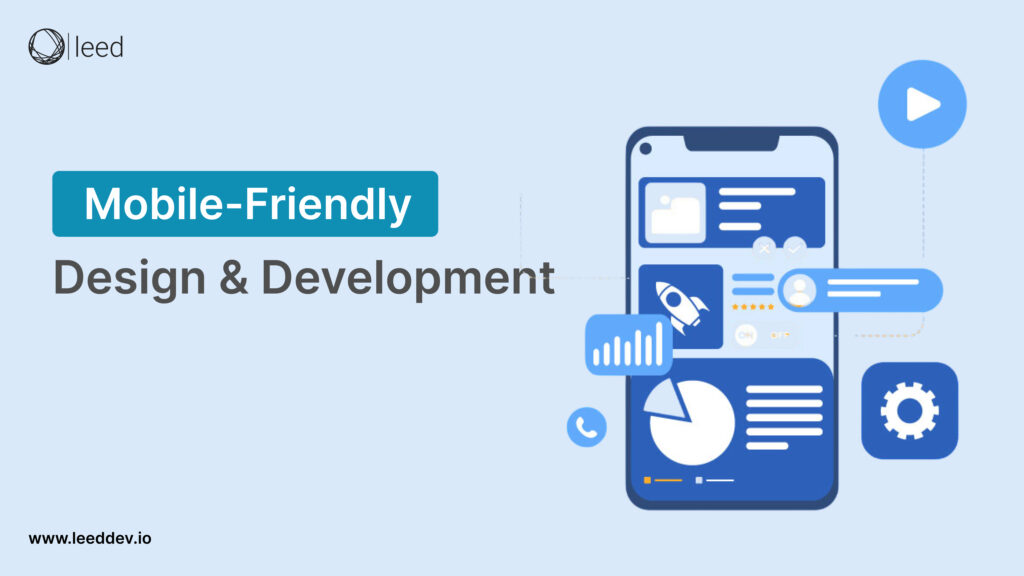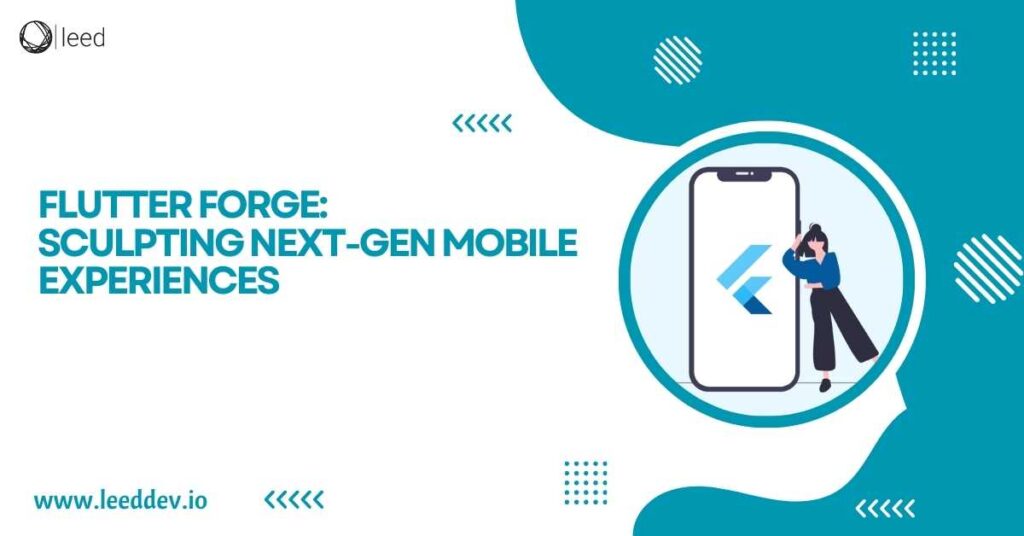In today’s hyper-connected world, our smartphones are practically extensions of ourselves. We use them for everything from checking emails and scrolling social media to online shopping and banking. A mind-blowing 96% of Americans now own a cellphone, and a staggering 75% of them use smartphones. With these numbers on the rise, it’s no surprise that having a mobile-friendly website or app is an absolute necessity.
This is where mobile-friendly design and development come in. It’s about creating digital experiences that are tailored specifically for mobile devices. It ensures users have a smooth, seamless, and enjoyable interaction with your brand.
What is Mobile Friendly Design and Development?
Mobile-friendly design and development is the practice of creating digital experiences specifically optimized for mobile devices like smartphones and tablets. It ensures users have a smooth, enjoyable interaction with your brand, regardless of the screen size they’re using.
- Responsive Design
- User-Centric Approach
- Fast Loading Speeds
In essence, mobile-friendly design and development is about creating a user-centric experience that translates seamlessly across all mobile devices.
Importance of Mobile Friendly Design and Development
The dominance of mobile is undeniable. Consider this: over half (54.8%) of all web traffic globally now comes from mobile devices. That means if your website isn’t optimized for mobile, you’re potentially alienating more than half your audience! A study by Google found that 53% of mobile users abandon a site that takes longer than 3 seconds to load. In the fast-paced world of mobile, users expect instant gratification. A slow-loading website translates to lost customers.
Benefits of Mobile-friendly Design and Development
Here are some of the benefits of mobile-friendly design and development:
- With the majority of web traffic coming from mobile devices, a mobile-friendly website ensures you don’t alienate a significant portion of your potential audience.
- A well-designed mobile experience is smooth, intuitive, and frustration-free, keeping users engaged and happy.
- Search engines like Google prioritize mobile-friendly websites in search results, making it easier for users to find your site.
- A positive mobile experience is more likely to convert visitors into leads or customers.
- A mobile-friendly presence showcases that your business is modern, user-centric, and keeps pace with the latest trends.
- Responsive design allows you to maintain a single website that adapts to all devices, saving on development and maintenance costs compared to separate mobile and desktop sites.
Read Also; Key Factors for Mobile App Development in 2025
Principles of Mobile Friendly Design and Development
Mobile-friendly design and development goes beyond just making things small enough to fit on a screen. It’s about understanding how users interact with their devices and creating an intuitive experience that caters to their needs. This includes:
Responsive Design
This is the cornerstone of mobile-friendly design. It ensures your website automatically adjusts its layout and content to fit the size of any device, be it a smartphone, tablet, or desktop computer. Here’s a deeper dive into what responsive design entails:
- Fluid Grids and Layouts: Instead of fixed layouts, responsive design uses flexible grids and layouts that can adapt to different screen sizes. Imagine a grid system with columns that resize and rearrange themselves based on the device. This ensures everything stays organized and easy to read, no matter the screen size.
- Media Queries: These are like checks that the website code performs to identify the device being used. Based on the screen size and resolution, the website applies the appropriate styles to optimize the layout.
- Scalable Images and Vector Graphics: Regular images can become pixelated or blurry when resized on different screens. Responsive design uses scalable images and vector graphics that can adjust their size without losing quality.
User Experience (UX)
User experience optimization is key to keeping users engaged on your mobile website. Here are some ways to achieve this:
- Simple and Clear Navigation: Complex menus and navigation systems can be frustrating on a small screen. Opt for clear menus with easy-to-understand labels, and prioritize the most important pages.
- Large and Legible Fonts: Tiny text is a recipe for frustration. Use fonts that are large enough to read comfortably on a mobile device, and ensure there’s enough contrast between the text and background color for good readability.
- Strategic Use of White Space: White space helps break up content and improve readability. Don’t clutter your mobile website with too much information or visual elements.
- Click-to-Call Buttons: Make it easy for mobile users to contact you by incorporating click-to-call buttons.
Fast Loading Speeds
Mobile users are impatient. A study by Google found that 53% of mobile users abandon a site that takes longer than 3 seconds to load. Here are some ways to optimize your website for speed:
- Image Optimization: Large images can significantly slow down loading times. Compress images to reduce their file size without sacrificing quality.
- Minify Code: Minifying code involves removing unnecessary characters and formatting from your website’s code, making it leaner and faster to load.
- Leverage Caching: Caching stores frequently accessed files on a user’s device, so they don’t have to be downloaded again on subsequent visits. This can significantly improve loading times.
Touch Friendly Design
Since most mobile users interact with their devices using touch, it’s crucial to ensure your website elements are touch-friendly. This means:
- Larger Buttons and Links: Buttons and links should be large enough for easy tapping with a finger. The recommended minimum tap target size is 48 x 48 pixels.
- Proper Spacing Between Elements: Avoid placing clickable elements too close together to prevent accidental taps.
User Centric Approach
Mobile apps offer a more immersive and interactive user experience compared to websites. When crafting a mobile app, prioritize these aspects for a user-centric approach:
- Focus on Value Proposition: What unique value does your app offer users? Identify a problem your app solves or a need it fulfills, and ensure this value is communicated clearly.
- Simple and Intuitive Interface: Mobile apps should be easy to navigate and understand. Avoid overwhelming users with complex features or cluttered interfaces.
- Offline Functionality: Not everywhere has a reliable internet connection. Consider functionalities that can be used offline, enhancing user experience even when data connectivity is limited.
- Push Notifications (Used Wisely): Push notifications can be a powerful tool for keeping users engaged, but overuse can lead to frustration. Use them strategically for important updates or personalized promotions.
- App Store Optimization (ASO): This ensures your app gets discovered in app stores. Optimize your app title, description, and keywords to improve its ranking in search results.
Difference Between Mobile-Friendly Design and Development Vs Web Design and Development
This table outlines the key differences in approach and considerations between mobile-friendly design and development vs web design and development.
| Aspect | Mobile-Friendly Design & Development | Web Design & Development |
| Screen Size | Optimized for smaller screens (smartphones, tablets) | Optimized for larger screens (desktops, laptops) |
| Navigation | Simplified, touch-friendly navigation | Detailed, mouse/keyboard navigation |
| Layout | Single-column layout, vertical scrolling | Multi-column layout, both vertical and horizontal scrolling |
| Images and Graphics | Smaller images, optimized for quick load times | Higher resolution images, more detailed graphics |
| Text Size | Larger text for readability on small screens | Standard text size, more content visible on screen |
| Interactivity | Tap-based interactions, gestures | Click-based interactions, hover effects |
| Content | Concise, prioritized content for quick access | Click-based interactions, hover effects |
| User Experience (UX) | Designed for on-the-go usage, intuitive, easy-to-use | Designed for comprehensive use, detailed interfaces |
| Development Frameworks | Use of responsive frameworks (e.g., Bootstrap, Foundation) | Use of comprehensive web frameworks (e.g., Angular, React) |
| Testing | Extensive testing on various mobile devices and screen sizes | Testing on various desktop browsers and resolutions |
| Updates & Maintenance | Frequent updates for app stores, considering OS updates | Regular updates, browser compatibility maintenance |
| Connectivity | Considers limited mobile data connectivity | Assumes stable and high-speed internet connectivity |
Conclusion
In today’s mobile-first world, ensuring your website or app is mobile-friendly is no longer an option, it’s a necessity. By following the principles of mobile-friendly design and development, you can create user-centric experiences that keep your audience engaged and coming back for more.
FAQs
What’s the difference between responsive design and mobile-friendly design?
Responsive design is a technique that ensures your website automatically adjusts its layout for any device, while mobile-friendly design is a broader concept that encompasses all aspects of creating a positive user experience on mobile devices.
How important are loading speeds for mobile websites?
Extremely important! Mobile users are impatient, and slow loading times can lead to them abandoning your site altogether.
Should I use a mobile app or a mobile-friendly website?
It depends on your goals. Apps offer a more immersive experience, but websites are easier to develop and maintain. Consider what functionality you need and how users will interact with your content.
How can I make sure my buttons are easy to tap on mobile?
Make sure your buttons are large enough for a finger (at least 48 x 48 pixels) and there’s enough space between them to avoid accidental taps.
What are push notifications and how should I use them?
Push notifications are messages that pop up on a user’s device. Use them strategically for important updates or promotions, but avoid overuse to prevent frustration.




